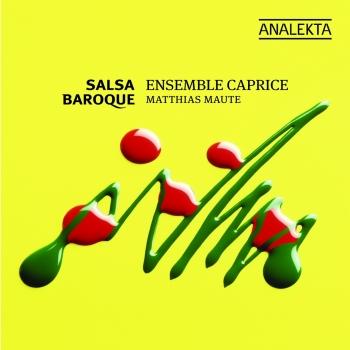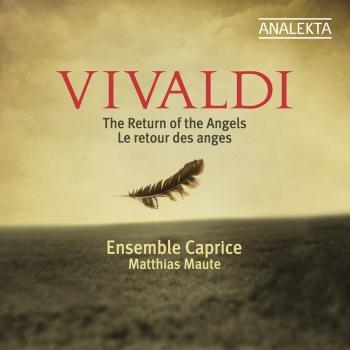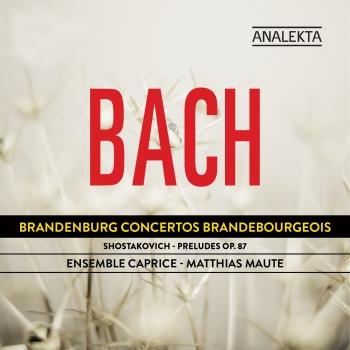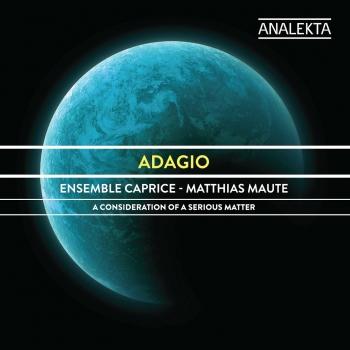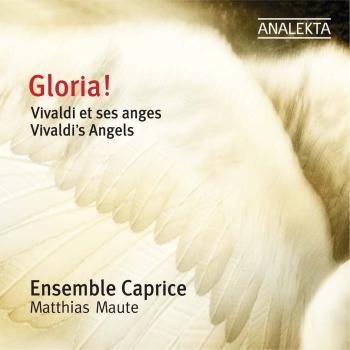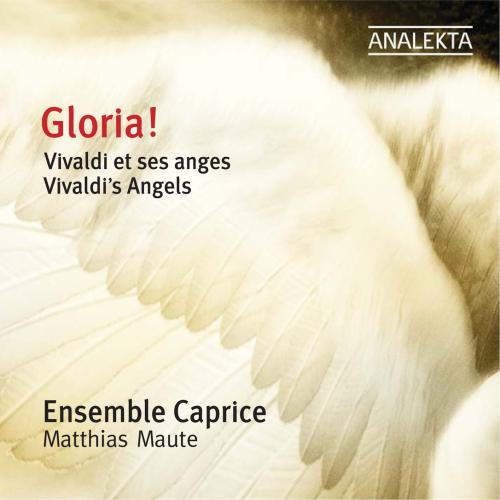
Gloria! Vivaldi's Angels Ensemble Caprice & Matthias Maute
Album info
Album-Release:
2008
HRA-Release:
31.07.2020
Label: Analekta
Genre: Classical
Subgenre: Chamber Music
Artist: Ensemble Caprice & Matthias Maute
Composer: Antonio Vivaldi (1678-1741)
Album including Album cover
- Antonio Vivaldi (1678 - 1741): Gloria In D major, RV 589:
- 1 Gloria In D major, RV 589: I. Allegro: Gloria In Excelsis Deo 02:17
- 2 Gloria In D major, RV 589: II. Andante: Et In Terra Pax Hominibus 03:32
- 3 Gloria In D major, RV 589: III. Allegro: Laudamus Te 02:09
- 4 Gloria In D Major, Rv 589: IV. Adagio: Gratias Agimus Tibi 00:26
- 5 Gloria In D Major, Rv 589: V. Allegro: Propter Magnam Gloriam Tuam 00:47
- 6 Gloria In D Major, Rv 589: VI. Largo: Domine Deus, Rex Coelestis 03:01
- 7 Gloria In D Major, Rv 589: VII. Allegro: Domine Fili Unigenite 02:17
- 8 Gloria In D Major, Rv 589: VIII. Adagio: Domine Deus, Agnus Dei 04:10
- 9 Gloria In D Major, Rv 589: IX. Adagio: Qui Tollis Peccata Mundi 00:55
- 10 Gloria In D Major, Rv 589: X. Allegro: Qui Sedes Ad Dexteram Patris 02:05
- 11 Gloria In D Major, Rv 589: XI. Allegro: Quoniam Tu Solus Sanctus 00:48
- 12 Gloria In D Major, Rv 589: XII. Allegro: Cum Sancto Spiritu 02:44
- Motet In C Minor “In Furore Iustissimae Irae”, Rv 626:
- 13 Motet In C Minor “In Furore Iustissimae Irae”, Rv 626: I. Aria: In Furore Iustissimae Irae (Allegro) 04:10
- 14 Motet In C Minor “In Furore Iustissimae Irae”, Rv 626: II. Recitativo: Miserationum Pater Piissime 00:30
- 15 Motet In C Minor “In Furore Iustissimae Irae”, Rv 626: III. Aria: Tunc Meus Fletus Evadet Laetus (Largo) 06:46
- 16 Motet In C Minor “In Furore Iustissimae Irae”, Rv 626: IV. Alleluia (Allegro) 01:31
- Concerto For 2 Recorders, Strings And Continuo In D Minor, Rv 535 :
- 17 Concerto For 2 Recorders, Strings And Continuo In D Minor, Rv 535 : I. Largo 01:23
- 18 Concerto For 2 Recorders, Strings And Continuo In D Minor, Rv 535 : II. Allegro 02:04
- 19 Concerto For 2 Recorders, Strings And Continuo In D Minor, Rv 535 : III. Largo 02:09
- 20 Concerto For 2 Recorders, Strings And Continuo In D Minor, Rv 535 : IV. Allegro Molto 02:29
- Motet In D Major “Ostro Picta”, Rv 642: I. Aria:
- 21 Motet In D Major “Ostro Picta”, Rv 642: I. Aria: Ostro Picta (Allegro) 02:46
- 22 Motet In D Major “Ostro Picta”, Rv 642: II. Recitativo: Sic Transit Vana 01:10
- 23 Motet In D Major “Ostro Picta”, Rv 642: II. Aria: Linguis Favete (Allegro) 03:12
- Magnificat, Rv 610:
- 24 Magnificat, Rv 610: I. Adagio: Magnificat Anima Mea 00:54
- 25 Magnificat, Rv 610: II. Allegro: Et Exultavit 01:59
- 26 Magnificat, Rv 610: III. Andante Molto: Et Misericordia 03:04
- 27 Magnificat, Rv 610: IV. Presto: Fecit Potentiam 00:27
- 28 Magnificat, Rv 610: V. Presto: Deposuit Potentes 00:49
- 29 Magnificat, Rv 610: VI. Allegro: Esurientes Implevit 01:15
- 30 Magnificat, Rv 610: VII. Largo: Suscepit - Allegro: Recordatus 00:39
- 31 Magnificat, Rv 610: VIII. Allegro Ma Poco: Sicut Locutus 01:31
- 32 Magnificat, Rv 610: IX. Largo: Gloria Patri 01:34
Info for Gloria! Vivaldi's Angels
One of Antonio Vivaldi’s most well-known pieces, the Gloria (RV 589) for choir and orchestra reveals an unexpected sound concept when performed by a woman’s choir. At first, the idea appears bizarre because the notation of the choir’s parts purports to indicate a conventional choir of mixed gender with a bass line (with bass-clef) and a tenor line being included. However, this assumption becomes less likely when the historical circumstances are scrutinized.
During his almost forty years of service at the orphanage Ospedale della Pietà, to which boys were not admitted, Antonio Vivaldi (1678-1741) taught numerous young female students both as a violin and a vocal teacher. Among the approximately one thousand orphans (figlie di commun) at the Ospedale, only fifty qualified as privileggiate di coro among the musically active figlie di coro. These exceptionally talented young women became a sensation in Italy. Even today, Vivaldi’s scores are a reflection of their amazing virtuosic playing and singing, which inspired his numerous musical flights of fancy.
Our Gloria! Vivaldi’s Angels recording has been created in posthumous homage to the incredible music that Vivaldi composed for the orphans of the Ospedale. One can picture the scene when concerts were presented at the Church of La Pietà. These performances attracted a large audience, whose attendance was for a number of reasons, the first being the wonderful effect that the playing and singing produced.
The female choir members must have sounded like angels in paradise while, at the same time, it seemed almost inconceivable that such young girls could master the excessively difficult concertos that their teacher Vivaldi had composed for them. It must have caused a sensation! Furthermore, the effect was intensified because the young women were hidden behind a barrier so that no one could see them. The most famous musicians of the orphanage were completely anonymous! An important social consequence of this phenomenon was that the Ospedale became somewhat of a wedding agency.
“Angels” were highly in demand, and so, while the Sunday concerts had a musically-knowledgable audience, there was also a certain percentage of men who were simply looking for an angelic future wife. Listening to the golden sound of the music without being able to see any of the musicians must have given the impression of being at the doors of paradise – or at least as close to paradise as one could be on earth! Occasionally, and as an exception, the strict rules of the Ospedale were relaxed and some of the young women were permitted to leave the walls of their “golden prison” (always chaperoned by a nun) if someone had requested a meeting.
Returning to the purely musical aspects of life at the Ospedale, the standard of the young musicians was so extraordinary that it was comparable only to the best orchestras at the most prestigious courts.Vivaldi clearly knew how to set the stage for these talented young women. On some scores, he indicated the name of the girl who was to sing a particular part and he knew how to flaunt the musical strengths of every singer and musician who interpreted his music.
As a result, it’s not difficult to appreciate the highly instrumental quality of his vocal music. Arias like Laudamus te (Gloria RV 589) and Esurientes (Magnificat RV 610) have vocal lines that resemble virtuosic violin music. And in the dramatic motet In furore, the solo soprano voice competes with the strings to depict both the boundless fury of the first air and the languishing sadness of the second. The same sparkling agility is required of the soprano voice in Ostro picta (RV 642) which, according to the indication in its title, served as an introduction to the Gloria.
However, the major surprises in the works on this recording are found in the choir music. The close harmony sound enhances the impact of dissonances considerably, because the intervals between the registers from soprano to bass are smaller than those of a choir of mixed gender. The effect is stunning, as can be heard in the movements Et in terra pax (Gloria RV 589) and Et misericordia eius (Magnificat RV 610). According to reports written at the time, sometimes members of the audience at La Pietà would cry and cheer enthusiastically during the performances of the most accomplished singers.
Concerto for two soprano recorders, RV 535: We took pleasure in adding another “soprano” piece to this recording, a concerto for two soprano recorders, strings and basso continuo (RV 535). While the two solo parts were originally conceived for two oboes, we have every confidence that Vivaldi, who composed so well for the young women at the orphanage who played the recorder, would not have objected to the reinstrumentation of this pearl among his concertos.
Monika Mauch, soprano
Shannon Mercer, soprano
Sophie Larivière, artistic director
Ensemble Caprice
Matthias Maute, conductor, recorder
Ensemble Caprice
a baroque ensemble which performs on period instruments, was founded by acclaimed conductor, composer and recorder soloist Matthias Maute and has become known for its innovative and adventuresome approach to an increasingly expanding musical repertoire. In addition to its series of concerts in Montreal, the group tours extensively, giving dozens of concerts in Canada, the USA, Europe, and even Asia. The ensemble is a regular guest at many prestigious European festivals: the Lufthansa Festival of Baroque Music in London, the Bruges (Belgium) and Utrecht (Netherlands) festivals, the Felicja Blumenthal International Music Festival in Tel Aviv; and in Germany, the Musikfestspiele Potsdam Sanssouci, the Regensburg Early Music Festival, the Händel-Festspele in Halle, and the Stockstadt festival. In November 2009, the New York Times published a lengthy article hailing the musicians’ innovative and refreshing approach, praising them as “imaginative, even powerful; and the playing is top-flight”.
The Ensemble’s recording activity is every bit as impressive. Their albums have gained many honours and much critical acclaim. The CD Gloria! Vivaldi and his Angels received a JUNO Award and three prestigious Prix Opus awards. Ensemble Caprice was also recognized for its artistic approach and the quality of its performances by being selected “People’s choice” and was a finalist in the music category for the Montreal Arts Council’s Grand Prix de Montréal. The group also earned a nomination for the Echo Klassic award in Germany and the acclaimed publication Gramophone magazine chose the group’s CD Telemann and The Baroque Gypsies as one of its recommended recordings. Ensemble Caprice produces videos for the website noncerto which promote classical music in a new way.
Matthias Maute
JUNO Award winning conductor, composer, recorder and flute soloist Matthias Maute has achieved an international reputation. Impressed by his artistic approach, The New York Times described the orchestra he conducts, Ensemble Caprice, as being “an ensemble that leads the listener to rehear the world”. He regularly appears at major festivals. In Canada he has performed at the Ottawa International Chamber Music Festival, the Festival international du Domaine Forget and the Elora Festival among others.
Maute’s recording of Bach’s Brandenburg Concertos juxtaposed with (his own orchestral arrangements of) Preludes from Shostakovich’s Op. 87 was hailed by The New Yorker’s Alex Ross as standing out “for its fleet, characterful approach” and “its fresh, vibrant colors”. Matthias Maute’s compositions are published by Breitkopf & Härtel, Amadeus, Moeck and Carus. His compositions are featured in numerous videos on the noncerto website. In 2014 and 2015, Maute’s 1st Violin Concerto was performed by soloist Mark Fewer and the St. John’s Symphony as well as by I Musici de Montréal. Matthias Maute has made some twenty recordings. He currently teaches in Montreal at both the Université de Montréal and McGill University.
Sophie Larivière
has participated in the International Recorder Symposium in Stuttgart, the Recorder Series in Schwelm, and the Recorder Festival of Stockstadt in Germany. She has been a member of Ensemble Caprice since 1997 and is the artistic co-director. In this function, she has contributed to the enrichment of the Ensemble, leading audiences to musical discoveries featuring both virtuosity and artistry. She has also been a guest performer with several early music ensembles, including Arion, Le Concert Spirituel, Les Idées Heureuses, Les Violons du Roy, Rebel, Le Studio de Musique Ancienne de Montréal, the New York Collegium and the Theatre of Early Music. In 2003 and 2004, under Jeunesses Musicales du Canada’s tutelage, Larivière took part in some 30 concerts throughout Quebec, Ontario and New Brunswick. In June 2004, with Ensemble Caprice, she performed for the first time in Austria, and few months later took part in a series of concerts at the Boston Early Music Festival. In the fall of 2006, she made her debut in Israel with the Ensemble Caprice in a series of concerts in Tel Aviv and Yehiam.
With Le Concert Spirituel (Paris), she took part in an American tour that led her to Detroit, Chicago and Washington. She has performed under such renown conductors as Andrew Parrott, Hervé Niquet, Philipp Picket, Jaap ter Linden and Barthold Kuijken, She is second traverso of the REBEL Baroque Orchestra in New York under the direction of Owen Burdick. She has recorded with Ensemble Caprice, Arion, Rebel, the Theatre of Early Music, and the Violons du Roy.
This album contains no booklet.









